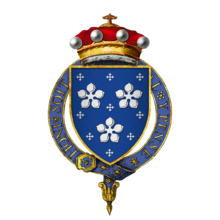
Baron Darcy de Darcy, also known as Baron Darcy of Temple Hurst, was a title which was created twice in the Peerage of England. On 17 October 1509 Thomas Darcy was summoned to parliament, and the same year Lord Darcy was invested as a Knight of the Garter, but in 1538, he was attainted and his barony forfeited. In 1548, a fresh creation of the peerage was made for his son George. On the death of the third baron of the second creation in 1635, the barony became extinct.